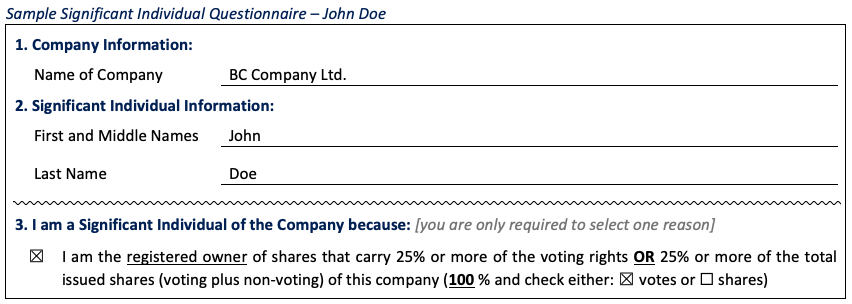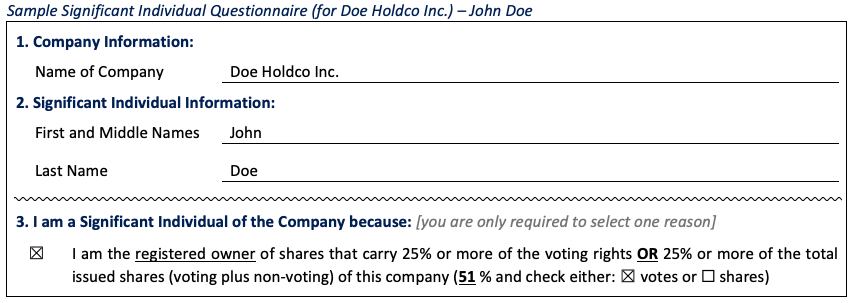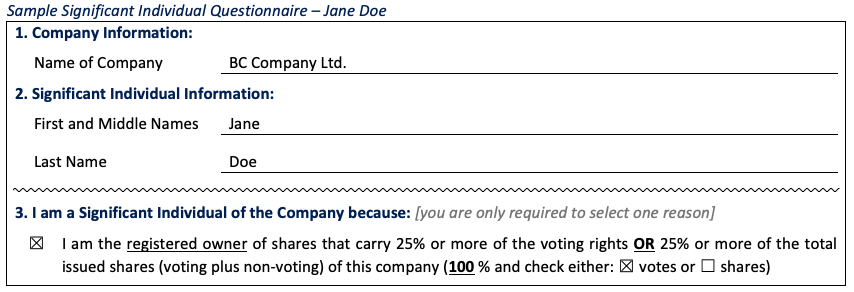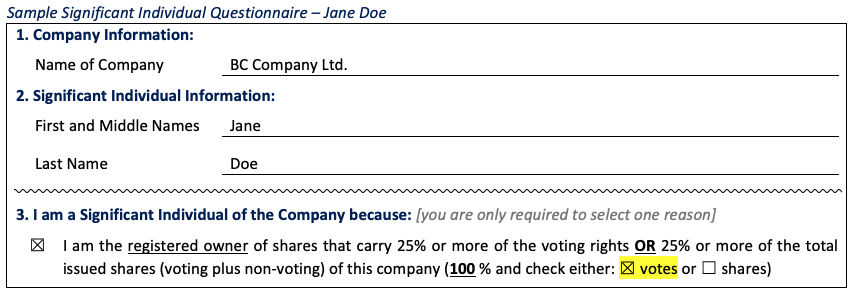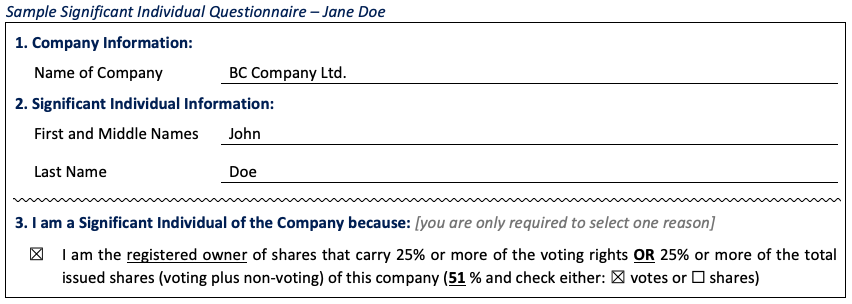This information is intended for privately-owned B.C. companies for which BTM Lawyers LLP acts as the records office. It includes examples of common corporate structures and provides instructions for completing the Significant Individual Questionnaire in each case, for the purpose of determining who the significant individuals of the company are and generating a Transparency Register. This information is provided for general guidance only and may not be applicable to your particular company’s circumstances. Please consult a lawyer if you require further assistance.
1. Companies with one owner (natural person)

John Doe is the sole shareholder of BC Company Ltd. In this example, he owns a single class of voting Common shares, but the same would apply if he owned multiple classes of shares.
He is a significant individual because he is the registered owner of shares that carry 25% or more of the voting rights. He is also a significant individual because he is the registered owner of 25% or more of the total issued shares, and has the right to elect, appoint, or remove the majority of the directors. However, only one reason needs to be listed on the Transparency Register. John must submit the Questionnaire, which could be completed as follows:
2. Companies with one owner (holding company)

Doe Holdco Inc. (John Doe’s holding company) is a privately-owned BC company and is the sole shareholder of BC Company Ltd. (the operating company). Doe Holdco Inc. is an “intermediary” entity in the chain of ownership of BC Company Ltd. and cannot be a significant individual because it is not a natural person (human being). Therefore, we need to determine if there are any natural persons who indirectly control BC Company Ltd. through their direct control of the intermediary.
John has control of the intermediary because he can elect or appoint a majority of its directors (i.e. because he owns 51% of the voting shares). As a result, John is a significant individual of BC Company Ltd. In this example, there is only one intermediary between John (the significant individual) and BC Company Ltd., but the same would apply if there were multiple wholly-owned intermediaries in the chain (e.g. if BC Company Ltd. was in the business of property development, a liability-management strategy may be to hold the property in a separate corporation under the operating company).
John is also a significant individual of Doe Holdco Inc. because he is the registered owner of shares that carry 25% or more of the voting rights and of 25% or more of the total issued shares, and has the right to elect, appoint, or remove the majority of its directors. Only one reason needs to be listed on the Transparency Register. John must submit two Questionnaires (one for BC Company Ltd. and one for Doe Holdco Inc.), which could be completed as follows:
Note: If there were multiple shareholders of BC Company Ltd. and/or multiple share classes, the same would apply as long as Doe Holdco Inc. owned at least 25% of the voting shares or total issued shares of BC Company Ltd.
Note: If this example is modified such that John is one of five independent shareholders of Doe Holdco Inc., each of whom owns 20 Class A Common shares out of 100 total issued shares, then neither BC Company Ltd. nor Doe Holdco Inc. would have any significant individuals listed in their respective Transparency Registers. This is because there would not be any registered owners with a significant number of shares of Doe Holdco Inc. and there would not be any natural persons with indirect control of BC Company Ltd. through their direct control of Doe Holdco Inc. (since none of the five shareholders of Doe Holdco Inc. would hold enough shares to elect or appoint a majority of its directors, without further facts to suggest otherwise).
3. Companies with two owners (equal ownership, both voting)

John Doe and Bob Smith are equal shareholders of BC Company Ltd. In this example, each of them owns a separate class of voting Common shares, but the same would apply if there was only one class of voting shares.
Each of them is a significant individual because they are a registered owner of shares that carry 25% or more of the voting rights. Each of them is also a significant individual because they are a registered owner of 25% or more of the total issued shares. However, only one reason needs to be listed on the Transparency Register. Each shareholder must submit their own Questionnaire, which could be completed as follows:
4. Companies with two owners (unequal ownership, both voting)
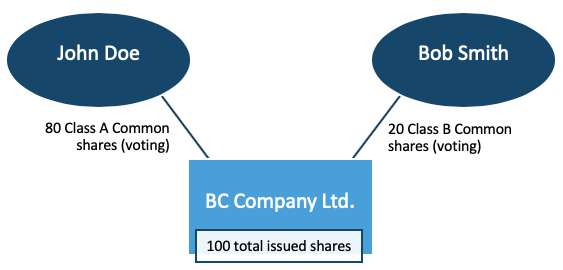
John Doe is a majority shareholder and Bob Smith is a minority shareholder of BC Company Ltd. In this example, each of them owns a separate class of voting Common shares, but the same would apply if there was only one class of voting shares.
John is a significant individual because he is the registered owner of shares that carry 25% or more of the voting rights. He is also a significant individual because he is a registered owner of 25% or more of the total issued shares, and has the right to elect, appoint, or remove the majority of the directors. However, only one reason needs to be listed on the Transparency Register.
Bob is not the registered owner of a significant number of shares. If there are no other facts which would cause him to be a significant individual, Bob will not be listed on the Transparency Register. However, each shareholder must still submit their own Questionnaire, which could be completed as follows:
Note: If this example is modified such that John transfers 5 or more of his Class A Common shares to Bob, then Bob would become a registered owner of shares that carry 25% or more of the voting rights (i.e. Bob would own 5 Class A Common shares plus 20 Class B Common shares out of 100 total issued shares), at which point the Transparency Register would need to be updated to add Bob as a significant individual alongside John.
5. Companies with two owners (voting and non-voting spouse)

Jane Doe and John Doe are equal shareholders of BC Company Ltd. In this example (a common income-splitting strategy), they are spouses, and each of them owns a separate class of Common shares (one voting and one non-voting class), but the same would apply if they were not spouses and/or if John owned non-voting Preferred shares instead.
Jane is a significant individual because she is the registered owner of shares that carry 25% or more of the voting rights. John is a significant individual because he is the registered owner of 25% or more of the total issued shares. There may be other reasons why each of them is a significant individual. However, only one reason needs to be listed on the Transparency Register. Although they are spouses, each of them must submit their own Questionnaire, which could be completed as follows:
6. Companies with multiple owners (equal ownership, single share class)
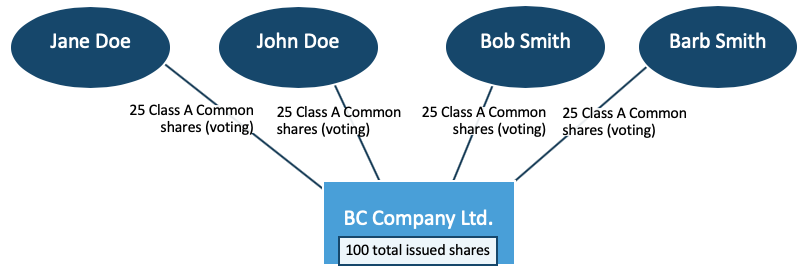
BC Company Ltd. has multiple shareholders. The test to determine whether each shareholder is a significant individual is the same as when there were only two shareholders. In this example, each of them is a significant individual because each is a registered owner of shares that carry 25% or more of the voting rights and 25% or more of the total issued shares. Only one reason needs to be listed on the Transparency Register. Each shareholder must submit their own Questionnaire, which could be completed as follows:
Note: If this example is modified such that there are five independent shareholders of BC Company Ltd., each of whom owns 20 Class A Common shares out of 100 total issued shares, then, without further facts to suggest otherwise, BC Company Ltd. would not have any significant individuals listed on its Transparency Register (since there would not be any registered owners with a significant number of shares of BC Company Ltd.).
7. Companies with multiple owners (equal ownership, multiple share classes)
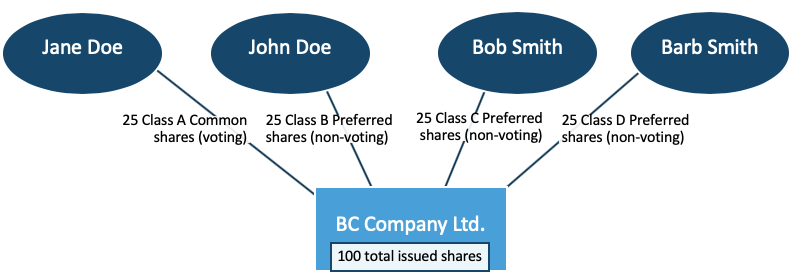
BC Company Ltd. has multiple shareholders. The test to determine whether each shareholder is a significant individual is the same as when there were only two shareholders. In this example, one individual is a voting shareholder while the others own separate classes of non-voting Preferred shares (possible scenario for companies with passive investors), but the same would apply if they owned non-voting Common shares.
Jane Doe is a significant individual because she is the registered owner of shares that carry 25% or more of the voting rights.
Each of the other shareholders is also a significant individual because they are a registered owner of 25% or more of the total issued shares. There may be other reasons why each shareholder is a significant individual. However, only one reason needs to be listed on the Transparency Register. Each shareholder is required to submit their own Questionnaire, which could be completed as follows:
Note: If this example is modified such that there are five independent shareholders of BC Company Ltd., each of whom owns 20 shares instead of 25 shares, then, without further facts to suggest otherwise, John, Bob, and Barb would no longer be significant individuals of BC Company Ltd. because they would no longer be registered owners of 25% or more of the total issued shares. However, Jane would remain a significant individual of BC Company Ltd. because she would still be the registered owner of shares that carry 25% or more of the voting rights (even if the 20 shares belonging to the fifth shareholder were voting shares).
8. Companies with multiple owners (unequal ownership, single share class)

Jane Doe is a majority shareholder of BC Company Ltd. and there are multiple minority shareholders. The test to determine whether each shareholder is a significant individual is the same as when there were only two shareholders.
Jane is a significant individual because she is the registered owner of shares that carry 25% or more of the voting rights. There may be other reasons why she is a significant individual. However, only one reason needs to be listed on the Transparency Register.
John, Bob, and Barb are not registered owners of a significant number of shares. If there are no other facts which would cause them to be significant individuals, then John, Bob, and Barb will not be listed on the Transparency Register. However, each shareholder must still submit their own Questionnaire, which could be completed as follows:
9. Companies with multiple owners (unequal ownership, multiple share classes)
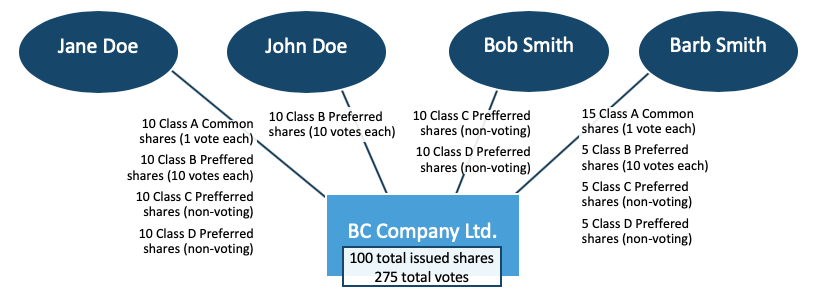
BC Company Ltd. has multiple shareholders and multiple classes of voting and non-voting shares. In this example the Articles of the company or the terms of a Shareholders’ Agreement provide that the holders of Class A Common shares are entitled to one vote per share and the holders of Class B Preferred shares are entitled to 10 votes per share (i.e. there are 275 total votes).
Bob Smith is not a significant individual because he does not own a significant number of shares.
Jane Doe is a significant individual because she is the registered owner of shares that carry 25% or more of the voting rights (110/275 = 40% of total votes).
John Doe is also a significant individual because he is the registered owner of shares that carry 25% or more of the voting rights (100/275 = 36.4% of total votes).
Barb Smith is not the registered owner of shares that carry 25% or more of the voting rights (65/275 = 23.6% of total votes). Nevertheless, Barb is a significant individual because she is the registered owner of 25% or more of the total issued shares (30/100 = 30% of total issued shares).
There may be other reasons why each of them is a significant individual. However, only one reason needs to be listed on the Transparency Register. Each shareholder is required to submit their own Questionnaire, which could be completed as follows:

